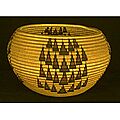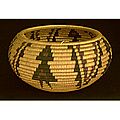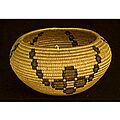Lena Frank Dick facts for kids
Quick facts for kids
Lena Frank Dick
|
|
|---|---|

Coiled basket by Lena Frank Dick
|
|
| Born |
Lena Frank
ca. 1889 Coleville, Antelope Valley, California, USA
|
| Died | 1965 |
| Years active | 1920s - 1935 |
| Known for | Washoe basket making |
| Spouse(s) | Levi Dick (m. 1906; died 1963) |
| Parent(s) | Charley and Lucy Frank |
Lena Frank Dick (born around 1889 – died 1965) was a talented Washoe basket maker. She was famous for her very tight weaves and unique designs. Her baskets were mostly made to be beautiful art, not just for everyday use.
Contents
About Lena Frank Dick
Lena Frank Dick was born in 1889. Her parents were Charlie and Lucy Frank. Her family was part of the Antelope Valley Washoe people. This group lived mainly in Nevada and California. Lena spent her whole life in the Antelope Valley. This area is near what is now Los Angeles County, California.
As a teenager, Lena married George Emm. They had one child, a daughter named Juanita. After Juanita was born, George Emm left. In 1906, Lena married Levi Dick, who worked in construction. Lena and Levi stayed married until he passed away in 1963. After his death, Lena stopped appearing in public. She passed away in 1965.
Lena was one of three daughters. Her mother taught her and her sisters to weave when they were young. Throughout her life, Lena was a well-known basket maker. She also helped deliver babies as a midwife. Lena performed important Washoe puberty ceremonies for her community.
Washoe Basket Weaving
Lena was known for her incredibly tight basket weaves. This was during a time called the "fancy basketry" period of Washoe art. For the Washoe tribe, making baskets has been important for hundreds of years. Baskets were used for both practical needs and as beautiful art.
The Washoe people lived in dry areas of Nevada and California. They often had to move from place to place. Their woven baskets, called degikup, were light and strong. This made them perfect for carrying things when moving. These baskets are made from young willow shoots. Black designs come from fern roots. Red designs come from a plant called western redbud (Cercis occidentalis).
To make a basket, weavers use an awl, a knife, and water. The water helps soak and soften the plant fibers. Different designs on the baskets could tell stories or share messages.
Washoe leaders sometimes gave baskets as gifts when dealing with other groups. For example, a basket was given to the Senate and House of Representatives in 1914. This basket showed events from early Nevada history. It specifically showed a time when the Washoe tribe gave weapons to white settlers. This helped them during the War of 1865, also known as the American Civil War. The basket was a reminder that the Washoe were willing to help. It was also a request for help from the government. The Washoe people had been given poor land. They could not use their traditional hunting grounds. This was because they could not afford hunting licenses. In this way, baskets were used as a political message. They also showed the amazing Washoe designs and craftsmanship.
In the late 1800s and early 1900s, people from Europe and America started to see Native basketry as a true art form. Some art lovers supported Native women who made baskets. During this time, Washoe basket makers created the degikup. This was a fine, coiled basket design that was almost perfectly round.
Lena's Artistic Journey
At first, Lena Dick's baskets looked like those made by Tootsie Dick Sam. Tootsie was a very important weaver in the Antelope Valley in the early 1900s. But over time, Lena Dick's work became more unique. Her style became more lively. She often used triangular shapes in her designs. Lena Dick also tried using colorful picture designs, like those by Sarah Mayo. However, after 1925, she stopped this style. She preferred lighter, geometric patterns instead.
In the mid-1920s, Lena Dick sold her baskets at a local grocery store in Coleville. A local rancher, Fred Settelmeyer, noticed how good her baskets were. He told Dr. Roscoe Day, who was a collector from San Francisco. Settelmeyer bought high-quality baskets for Dr. Day. Lena Dick then made her weaving even better. She also improved her designs. After this, Lena and her sister Lillie worked only for Roscoe A. Day. She made 13 baskets for him. After Dr. Day passed away, these baskets were sold to the State of California.
Lena Dick's artworks were often small, usually only four or five inches tall. They had wide openings. Lena was known for her very tight and exact stitching. She could make 25 to 33 stitches in just one inch. Compared to other famous basket weavers, Lena's career was short. By 1935, she stopped making these tiny designs. It became too hard for her eyes. She still made baskets, but they were more for everyday use than her earlier art pieces.
Other Famous Basket Weavers
Lena Frank Dick is known for 28 pieces made during her short career. But it wasn't until the late 1970s that she got credit for much of her work. Before that, Lena's baskets were often mistaken for those made by Datsolalee, also known as Louisa Keyser (1850-1925). Datsolalee's art was different from Lena's in a few important ways. First, her baskets were taller, usually about 14 inches. They also had small bases, wide middles, and narrow openings. However, both women used red and black colors. These colors were traditional for the Washoe people.
The baskets Lena made for Roscoe and that were sold to the State of California were all listed under Datsolalee's name. Lena saw this herself when she visited the Nevada State Museum with her granddaughter. She pointed out some of her own works among those that were said to be by Datsolalee. Datsolalee was also a very important basket weaver. She is often given credit for being the first to create baskets purely as art. Datsolalee had people who supported her work financially. This allowed her to focus all her time on making baskets for over 30 years.
Images for kids
See also




